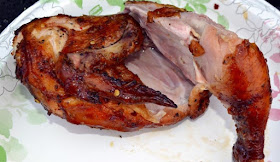 |
| Barbecued brisket with a low and slow bark cooked using the hot and fast method. |
The appetizing color and bark on barbecue is the result of several things going on during the cooking process but one of the most important things is known as the Maillard Reaction. This is where the natural sugars and proteins in meat begin to brown while cooking. There are several things that influence this reaction: sugar, protein, heat, and the pH level of the surface of the meat are a few. Sugar is often used to create a faux bark. Rather than a natural, delicious bark that is produced from only the interaction of heat, smoke and the natural sugars and proteins in the meat, the sugar on the surface caramelizes and becomes a crust. Too often, it burns and results in an unappetizing flavor and appearance.
One of the least-known aspects of how the Maillard Reaction produces bark on barbecue is the pH level of the surface of the meat. When meat has the proper pH level for the heat and length of time it is barbecued, the bark comes out perfect every time. So, to up your game as a pitmaster, I suggest that you dump the sugar in your barbecue rub and move to ingredients that balance the pH of the surface of the meat so that a natural bark is produced to your taste. If you have to have sugar, apply it late in the cooking process so that it can caramelize without burning or turning too dark.
There are several ways to influence the pH level of the surface of meat. Here are the essentials.
- The pH of a substance is an indication of its acidity
- The pH of pure water is 7. That means it's pH is neutral.
- The pH level of vinegar is between 2 and 3.
- Natural cocoa powder has a pH of 5.3 to 5.8. IMPORTANT NOTE - Dutch process cocoa powder is not recommended because it's not acidic enough. The way it's processed makes its pH level neutral.
- Baking soda, also known as sodium bicarbonate, has a pH of 9.
- When the pH of a substance is below 7, it slows the Maillard Reaction.
- When the pH of a substance is above 7, it speeds up the Maillard Reaction.
- Lower pH in food means it will take longer to brown.
- Higher pH in food means it will brown faster.
 |
| Delicious appetizing Shenandoah Valley Barbecue Chicken cooked for several hours over direct heat. |
When I want to lower the pH of meat without using vinegar, I add about 1/2 teaspoon of natural cocoa to enough of my rub recipe for a single brisket or pork butt. It won't change the flavor of your rub but will help slow down the production of bark.
When I cook barbecue hot and fast, I like to speed up the production of bark because I don't have 8 hours for the bark to develop. In those cases, I add something to increase the pH level of the meat such as baking soda. I add about 1/2 teaspoon to the rub recipe for one brisket or pork butt, for example. It doesn't take much baking soda, so don't worry about making a perceptible change to the flavor of your barbecue.
For more examples, read my other posts:
How to get a Low and Slow Bark on a Hot and Fast Brisket
Shenandoah Valley Barbecue Chicken
Picnic Fries

No comments:
Post a Comment